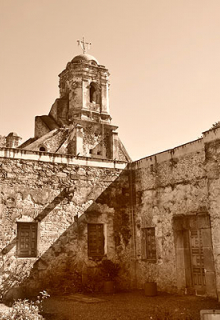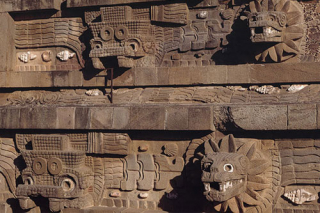Place: Mexico City and Chicanná (Campeche), Mexico
Partners
- ICCROM
- INAH
Background
In many regions of the world, stone was historically the predominant material used for building and artistic purposes. Accordingly, the conservation and maintenance of architectural and decorative stone is a core activity in such regions. Factors such as climate change, pollution, use demands, lack of maintenance, and inappropriate past treatments present challenges for the conservation of stone buildings, structures and objects. In addition to these factors, the decline in traditional building techniques, craft practices and repair methods is also threatening our ability to sustain stone structures and objects into the future. These conservation issues require a multidisciplinary approach that involves professionals, craftspeople, policy makers and owners.
The International Course on Stone Conservation was created in 1976. Nineteen courses have successfully been conducted between then and 2009 in Venice, and since 2011 it has been held biennially in Rome. The new course which will be held in Mexico reflects advances in practice, science, and technology, including the integration of practical methodologies for stone conservation on sites, buildings and structures.
Course objectives and programme
The course adopts a collaborative and multidisciplinary approach and is designed for professionals involved in the conservation of historic stone structures and artifacts. The primary goal of the course is to improve the practice of stone conservation internationally by providing participants with a holistic understanding of the decay and deterioration of stone, disseminating effective conservation methodologies, and ensuring a practical understanding of appropriate repair methods and long-term management strategies. Through lectures, discussions, laboratory sessions, demonstrations, site visits and field exercises, participants will discuss both the fundamental theories of conservation as well as consider how advances in technology and research have influenced practical approaches as they pertain to all phases of stone conservation. Group fieldwork exercises at a worksite will provide participants with the opportunity to address actual work scenarios where multidisciplinary solutions and collaboration are required. Throughout the course, participants will be encouraged to draw upon their collective expertise from various specializations to help them arrive at more effective conservation solutions.
The course will take place over eight weeks: four weeks in Mexico City and four weeks at the Mayan archaeological site Chicanná, in the State of Campeche. The training activities will include topics such as:
- Conservation principles and theories;
- Stone heritage in Mexico: formal, material and technical/constructive characteristics;
- Material sciences as a tool for identification, analysis, and design of conservation treatments;
- Mechanisms of deterioration;
- Diagnostic techniques for identifying causes and effects of observed conditions;
- Condition assessment methodology;
- Documentation;
- Developing a conservation strategy for immediate and long-term actions including prevention, maintenance, repair and treatment;
- Managing stone conservation projects and the value of working within multidisciplinary teams.
The course may include a preparatory phase prior to arrival in Mexico. This preparatory phase will include assigned readings to provide participants with a common knowledge base and familiarity with key literature that will be used during the course. The preparatory phase will be conducted in participants’ home countries.
During the course, participants will be expected to play an active role by contributing to discussions, exercises, and presentations reflecting their own professional experience.
Participants
The course is designed for a maximum of 20 participants. The course is open to archaeologists, architects, conservator-restorers, conservation scientists, engineers and other professionals involved in stone conservation, preferably with at least five years of practical working experience in the field.
Preference will be given to heritage conservation professionals in the public sector, teachers involved in the practical training of conservation professionals, and those in a position to disseminate and leverage the knowledge gained during the course to a wider audience. The participants will be selected from international conservation professionals.
Teaching team
Teaching staff will include an internationally recognized group of heritage conservation professionals who will represent a diverse array of perspectives based on their specialized expertise and their regional contexts.
Language
The course will be conducted in English. Candidates must have a thorough technical knowledge and command of English. A certificate of language proficiency is required.
Certificate
A certificate of attendance will be awarded to participants who satisfactorily complete the course and have attended at least 90% of all course activities.
Course fee: 900 € (Euro)
Travel, accommodation and living expenses
Participants will be responsible for their round trip travel costs to and from Mexico, including local flights to the city of Chetumal. In order to cover accommodation and living expenses in Mexico during the course, participants should plan for a minimum allowance of 2,700 € for the entire period including the local flight to/from Mexico City and Chetumal.
Candidates are strongly encouraged to seek financial support from sources such as governmental institutions, employers and funding agencies. In cases of proven financial need, depending on the availability of funding, the course organizers may be able to offer a limited number of scholarships to selected candidates who have been unable to secure funding.
Application
Please fill the ICCROM application form and send it together with the documents listed below to the following e-mail: stonecourse17 (at) iccrom (dot) org. All the documentation must be submitted in English.
- A complete professional curriculum vitae.
- A brief report (3-5 pages) answering the following questions:
- Describe the organization you work for and its role in stone conservation in your own country. What kind of stone heritage is your organization responsible for – built (immovable), collections (moveable), archaeological or other? Please describe.
- Describe a conservation project involving stone conservation for which you are or have been actively involved. Include the appropriate contextual background (objectives, partners, support, etc.), a description of difficulties encountered, and the strategic responses developed.
- In addition to the project described above, what other case studies might you be able to share during your participation in the course?
- What do you consider as your major achievement in stone conservation? Please describe what you did and why it is important to you.



